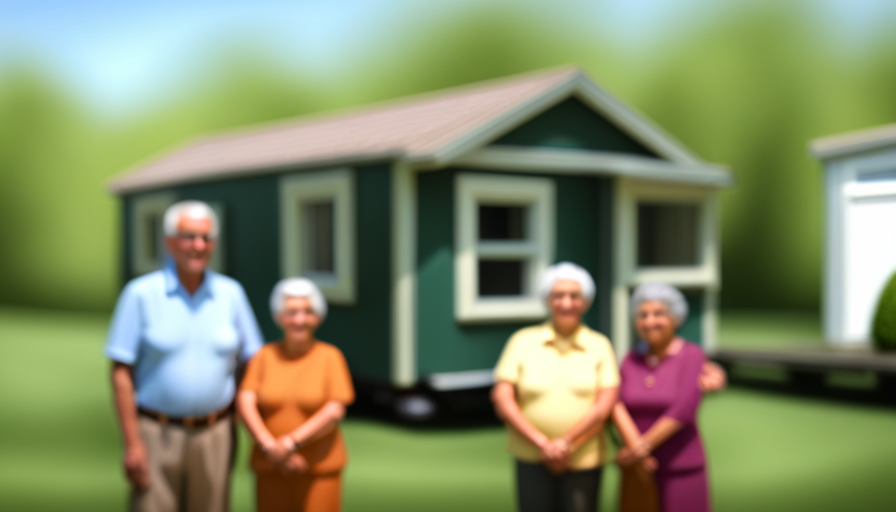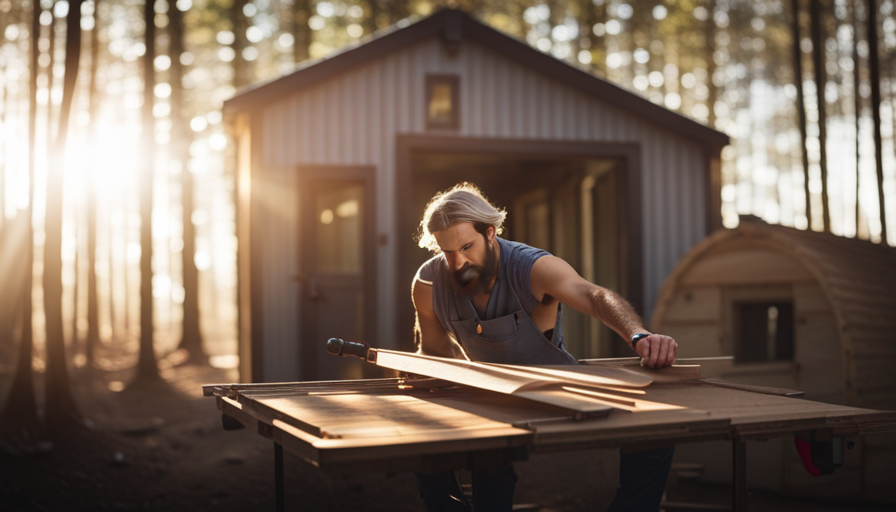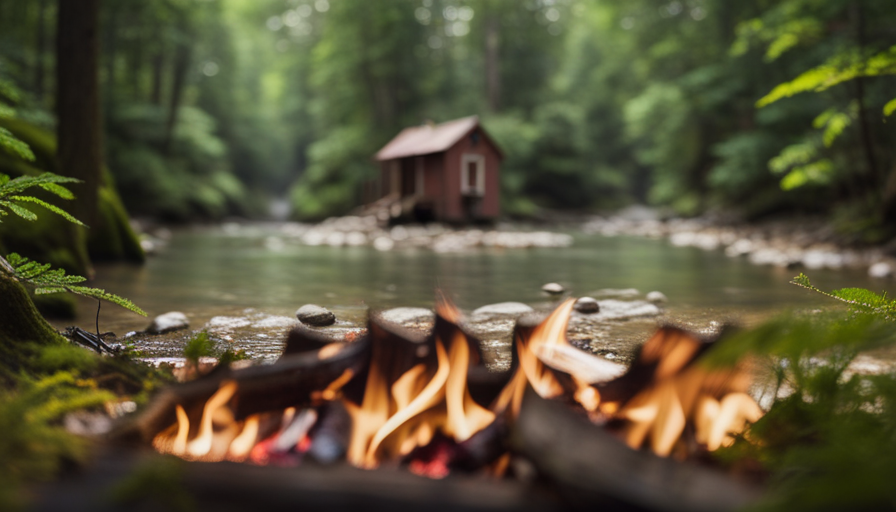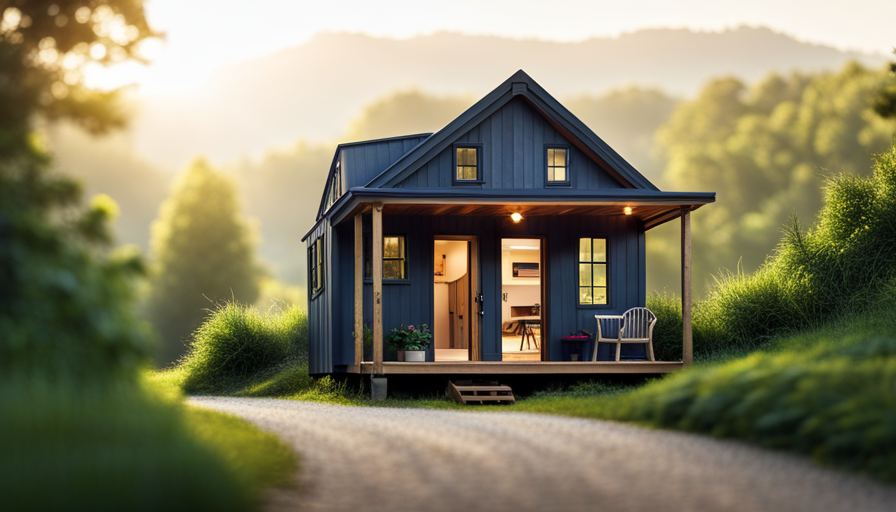Have you ever wondered how long people typically stay in tiny homes? This question sparks curiosity and interest as the tiny house movement continues to grow in popularity. During my research on this topic, I discovered a wide range of factors that can influence the lifespan of a tiny home. From design considerations to personal lifestyle choices, there are many variables at play.
In this article, we will explore the data and delve into the analytical side of tiny house living. We will examine the role of design in ensuring longevity, discuss common challenges faced by tiny homeowners, and provide case studies of thriving tiny house communities. Additionally, we will delve into the financial considerations and return on investment, as well as the emotional and psychological impact of living in a tiny house.
Whether you’re considering downsizing or simply curious about this unique lifestyle, this article will provide valuable insights to help you make an informed decision. Get ready to uncover the secrets behind the longevity of tiny house living.
Key Takeaways
- Factors such as construction materials, maintenance level, and exposure to weather conditions can affect the lifespan of a tiny house.
- Design considerations, such as using durable materials and regular maintenance, can increase the longevity of a tiny house.
- Lifestyle choices, including the number of occupants and frequency of relocation, can impact the lifespan of a tiny house.
- Efficient use of space is important for maximizing functionality and minimizing clutter in a tiny house.
Factors Affecting the Lifespan of a Tiny House
The lifespan of a tiny house can be influenced by various factors such as its construction materials, maintenance level, and exposure to weather conditions. Design considerations play a crucial role in determining how long a tiny house will last.
For instance, using durable materials like steel or concrete can increase the longevity of the structure. Additionally, regular maintenance, such as inspecting and repairing any damages, can extend the life of a tiny house. Neglecting maintenance can lead to structural problems and decrease its overall lifespan.
Exposure to harsh weather conditions is another significant factor that impacts the longevity of a tiny house. Extreme temperatures, heavy rain, or high winds can cause wear and tear on the structure over time. Proper insulation, reinforced foundations, and weather-resistant finishes can help mitigate the effects of weather conditions and extend the lifespan of a tiny house.
Furthermore, lifestyle choices can also impact the lifespan of a tiny house. Factors such as the number of occupants, usage patterns, and frequency of relocation can affect wear and tear on the structure. For example, constant moving can put stress on the tiny house, potentially leading to damages and reducing its lifespan.
Considering design considerations for longevity, such as using durable materials, regular maintenance, and accounting for weather conditions, is essential in ensuring that a tiny house can stand the test of time.
Design Considerations for Longevity
When considering the design of a tiny house for longevity, there are several key points to keep in mind.
First, efficient use of space is crucial in order to maximize functionality and minimize clutter.
Second, ensuring structural integrity and durability is essential to withstand the test of time and potential environmental factors.
Lastly, designing with flexibility for future needs in mind allows for adaptability as life circumstances change.
These factors contribute to the overall longevity and sustainability of a tiny house.
Efficient Use of Space
Living in a tiny house means maximizing every inch of space available. Efficient use of space is crucial to ensure that every nook and cranny serves a purpose. Maximizing storage is a key consideration in tiny house design, and there are various clever strategies to achieve this.
Built-in storage solutions such as hidden cabinets, under-bed drawers, and multi-functional furniture are commonly used to optimize space. Additionally, vertical storage is often utilized to maximize floor space, with shelves, hooks, and hanging storage systems. These space-saving techniques allow for a clutter-free living environment and ensure that everything has its designated place.
Transitioning to the next section about structural integrity and durability, it’s important to not only make efficient use of space but also ensure that the tiny house is built to last and withstand the test of time.
Structural Integrity and Durability
To ensure your tiny home is built to last and withstand the test of time, it’s important to investigate the truth of a theory and provide a visual representation of ideas regarding structural integrity and durability.
When it comes to tiny houses, structural safety is of utmost importance. Since these homes are generally built on a smaller scale, it is crucial to choose construction materials that are strong and reliable. Materials like steel and reinforced concrete can offer the necessary strength and stability.
Additionally, proper insulation and weatherproofing measures should be taken to protect the structure from potential damage. By ensuring the structural safety and durability of your tiny home, you can have peace of mind knowing that it will be able to withstand the demands of time and provide a safe living environment.
This leads us to the next topic of flexibility for future needs.
Flexibility for Future Needs
Imagine the endless possibilities of transforming your compact abode to adapt and accommodate your evolving needs over time.
One of the key advantages of a tiny house is its future adaptability. With limited space, it forces homeowners to think creatively and make the most of every square inch. This leads to innovative solutions for space optimization, such as multi-purpose furniture, built-in storage, and modular designs. These elements allow for easy reconfiguration and customization as your lifestyle changes.
Whether you need an extra bedroom, a home office, or a space for hobbies, a tiny house provides the flexibility to meet your future needs. By prioritizing functionality and efficiency, homeowners can maximize the longevity of their tiny homes.
This adaptability is just one aspect that contributes to the overall lifespan of a tiny house, which we will explore further in the next section.
The Role of Lifestyle in Tiny House Lifespan
With the right care and maintenance, tiny houses can stand the test of time, providing a cozy and sustainable living experience. The role of lifestyle in the lifespan of a tiny house cannot be underestimated. Here are three key factors to consider:
-
Community: Living in a tiny house often means being part of a close-knit community. This sense of belonging and support can have a positive impact on mental health, reducing stress and fostering a sense of connection. Studies have shown that strong social ties are associated with increased longevity and improved overall well-being.
-
Sustainable Living: Tiny houses promote a more sustainable lifestyle by encouraging minimalism and reducing carbon footprint. By adopting eco-friendly practices such as composting, rainwater harvesting, and using renewable energy sources, tiny house dwellers contribute to a healthier environment and potentially increase the lifespan of their homes.
-
Mindful Consumption: The limited space in a tiny house forces individuals to be more mindful about their consumption habits. This conscious approach to material possessions can lead to less waste and a more intentional lifestyle. By focusing on quality over quantity, tiny house owners can ensure that their homes remain functional and well-maintained for years to come.
Considering these factors, it is clear that lifestyle choices play a significant role in determining the lifespan of a tiny house. However, there are also common challenges and solutions to address, which will be discussed in the next section.
Common Challenges and Solutions
When it comes to living in a tiny house, there are a few common challenges that need to be addressed in order to ensure its longevity.
One of the key points to consider is moisture and mold prevention. The compact nature of a tiny house can lead to increased humidity levels, so it’s important to take steps to prevent moisture buildup.
Insulation and energy efficiency are also important factors. Proper insulation can help regulate temperature and reduce energy consumption, which is crucial in a small space.
Finally, structural stability in extreme conditions is crucial. Tiny houses can be more susceptible to damage from strong winds or heavy snow loads, so it’s important to ensure that the structure is built to withstand these challenges.
By addressing these challenges, we can ensure that tiny houses can withstand the test of time.
Moisture and Mold Prevention
To effectively prevent moisture and mold in your tiny house, you must consistently maintain proper ventilation and insulation, ensuring a healthier and longer-lasting living environment. By controlling moisture levels, you can mitigate the risk of mold growth and associated health issues. Here are five key strategies that can help prevent moisture and mold in your tiny house:
- Install a ventilation system to improve air circulation and reduce humidity.
- Use moisture-resistant materials for walls, floors, and ceilings.
Regularly inspect and repair any leaks or water damage.
Keep indoor humidity levels below 50% using dehumidifiers or air conditioners.
Allow for proper drying time after cooking, showering, or doing laundry.
These preventive measures can significantly reduce the chances of moisture-related problems in your tiny house, creating a comfortable and healthy living space.
Moving on to insulation and energy efficiency, it’s crucial to ensure optimal temperature regulation and minimize energy consumption.
Insulation and Energy Efficiency
Achieving optimal insulation and energy efficiency in your cozy sanctuary is like wrapping your tiny haven in a snug, insulating blanket, ensuring a cozy and eco-friendly haven. To achieve this, there are various insulation techniques and energy-efficient appliances that can be utilized. Insulating your tiny house properly can help maintain a comfortable temperature inside, reducing the need for excessive heating or cooling. This can be achieved by using insulation materials such as spray foam, rigid foam, or cellulose insulation. Additionally, energy-efficient appliances, such as low-energy refrigerators and LED lighting, can help minimize energy consumption. By implementing these insulation techniques and using energy-efficient appliances, you can create a sustainable and energy-saving environment in your tiny house. Transitioning into the subsequent section about ‘structural stability in extreme conditions’, it is important to ensure that your tiny house is not only energy-efficient but also built to withstand any potential challenges it may face.
Structural Stability in Extreme Conditions
Ensure that your cozy sanctuary can withstand extreme conditions by focusing on the structural stability of your small haven.
Tiny houses are often subjected to various weather conditions, including extreme heat, cold, wind, and precipitation. To ensure structural stability, it’s crucial to use high-quality materials and construction techniques that can withstand these harsh elements.
Additionally, incorporating energy-efficient features such as proper insulation and efficient heating and cooling systems can enhance the longevity of your tiny house in extreme weather conditions.
Furthermore, designing your tiny house with environmental sustainability in mind can contribute to its overall structural stability. Implementing renewable energy systems, such as solar panels, and utilizing sustainable materials can help reduce the environmental impact while also providing a more resilient structure.
Transitioning to the next section, let’s explore case studies that highlight the longevity of tiny house communities.
Case Studies: Longevity of Tiny House Communities
Living in a tiny house community can offer an average lifespan of over 10 years, providing a unique and sustainable lifestyle choice. Case studies on the longevity of tiny house communities have revealed interesting insights into community dynamics and social impact. Here are some key findings:
-
Strong sense of community: Residents in tiny house communities often develop close-knit relationships, fostering a supportive and inclusive environment.
-
Shared resources: Communities often promote resource-sharing, such as communal gardens, tool libraries, and shared spaces, which enhance sustainability and reduce individual carbon footprints.
-
Increased social interaction: Living in close proximity encourages social interaction, leading to improved mental well-being and a greater sense of belonging.
-
Minimalist lifestyle: Tiny house living encourages simplicity and minimalism, reducing materialistic desires and promoting a more sustainable consumption pattern.
These case studies highlight the positive impact and longevity of tiny house communities, showcasing the potential for a fulfilling and sustainable way of life. However, to fully embrace this lifestyle, it’s important to consider legal and regulatory considerations.
Legal and Regulatory Considerations
To fully embrace the potential of tiny house communities, it’s crucial for you to navigate the intricate landscape of legal and regulatory considerations. Zoning restrictions and building codes are two key factors that can significantly impact the longevity and success of a tiny house community. Zoning restrictions dictate where tiny houses can be located, while building codes outline the minimum standards for construction and safety. These regulations vary from place to place, so it’s important to thoroughly research and understand the rules in your specific area.
In order to provide a clearer understanding of the legal and regulatory considerations, I have created a table below:
| Consideration | Description |
|---|---|
| Zoning Restrictions | Determine where tiny houses can be located, whether it’s on private land or within a community. |
| Building Codes | Set the minimum standards for construction, ensuring safety and compliance with regulations. |
By adhering to zoning restrictions and building codes, you can ensure that your tiny house community is legally compliant and safe for residents. This will enhance the longevity and success of the community, as it will be able to withstand any legal challenges or issues that may arise.
Transitioning into the subsequent section about ‘financial considerations and return on investment,’ it’s important to understand the legal and regulatory landscape before diving into the financial aspects of a tiny house community.
Financial Considerations and Return on Investment
When considering the financial aspects of living in a tiny house, there are several key points to explore.
First, the cost of building and maintaining a tiny house can vary greatly depending on factors such as size, materials, and location.
Second, exploring the resale value and market trends of tiny houses can provide insight into the potential return on investment.
Lastly, one of the main appeals of living in a tiny house is the affordability and ability to live debt-free, which is an important consideration for many individuals.
Overall, understanding these financial considerations can help inform the decision to live in a tiny house.
Cost of Building and Maintaining a Tiny House
The affordability of building and maintaining a tiny house is a major factor that entices people to dive into this unique lifestyle. When considering the cost of maintenance and repairs, it is important to note that tiny houses typically have lower expenses compared to traditional homes. With fewer square footage and simplified systems, the cost of repairs and maintenance is significantly reduced. Additionally, the long-term sustainability of a tiny house contributes to its cost-effectiveness. These small dwellings often utilize eco-friendly materials and energy-efficient systems, resulting in lower utility bills and a smaller environmental footprint. To illustrate the financial advantages of a tiny house, consider the following table:
| Expense | Tiny House | Traditional House |
|---|---|---|
| Construction | $30,000 | $200,000 |
| Maintenance | $500/year | $2,000/year |
| Utilities | $50/month | $150/month |
| Total Cost (10 years) | $35,000 | $220,000 |
Considering the significant cost savings, it is no wonder that the tiny house movement continues to gain popularity. Looking ahead, it is important to also consider the resale value and market trends.
Resale Value and Market Trends
Considering the resale value and current market trends, you’ll be intrigued to learn that tiny houses have seen a 67% increase in demand over the past five years. This surge in popularity has resulted in a positive impact on the resale value of tiny houses.
Here are some key trends and factors driving the market:
- Growing interest from millennials, who value minimalistic living and affordable housing options.
- Increasing environmental consciousness, with tiny houses being seen as a sustainable housing solution.
- Flexibility and portability, allowing homeowners to easily relocate and adapt to changing circumstances.
These market trends indicate a promising future for tiny house owners in terms of potential resale value. With the rising demand and favorable market conditions, it’s clear that investing in a tiny house can be a wise financial decision.
Moving forward, let’s explore how tiny houses offer affordability and the promise of debt-free living.
Affordability and Debt-Free Living
Imagine living in a home that not only fits your budget but also allows you to live without the burden of debt. This is the reality for many people who choose to live in tiny houses. The affordability of these compact dwellings offers financial independence and the opportunity to embrace a minimalist lifestyle.
By downsizing their living space, individuals can significantly reduce their expenses, making it easier to achieve debt-free living. According to data, the average cost of building a tiny house is significantly lower than that of a traditional home. Additionally, the reduced size translates into lower utility bills and maintenance costs. The financial benefits of living in a tiny house provide individuals with the freedom to pursue their passions and goals, unencumbered by the weight of financial obligations.
Transitioning into the subsequent section about the emotional and psychological impact of tiny house living, it’s fascinating to explore how this lifestyle choice can positively influence well-being.
The Emotional and Psychological Impact of Tiny House Living
Living in a tiny house can truly transform your emotional and psychological well-being. The minimalistic lifestyle and the freedom from material possessions can have a profound impact on one’s emotional well-being. The simplicity of tiny house living allows individuals to focus on what truly matters, leading to a greater sense of contentment and fulfillment.
Additionally, living in a tiny house promotes a sense of community and connection, which can help combat social isolation. Imagine waking up in your cozy loft bed, surrounded by the soft glow of natural light streaming through the small windows. You step onto the reclaimed wood floor, feeling the warmth under your feet as you make your way to the compact kitchen. The smell of fresh coffee fills the air as you prepare your morning cup. Outside, you step onto your tiny porch and take a deep breath of crisp, clean air, feeling a sense of peace wash over you.
Living in a tiny house allows individuals to simplify their lives and prioritize their well-being. The small space fosters a sense of mindfulness and intentionality, encouraging residents to be present in the moment and appreciate the little things in life. This increased awareness can lead to reduced stress levels and improved mental health.
Transitioning to the next section about ‘tiny house living for different life stages’, individuals of all backgrounds and ages can benefit from the emotional and psychological advantages of tiny house living.
Tiny House Living for Different Life Stages
As a young professional or single person, tiny house living can offer numerous benefits. It provides an affordable housing option in expensive urban areas, allowing for financial flexibility and the ability to save money. Additionally, the small size of a tiny house promotes a minimalist lifestyle, encouraging individuals to prioritize experiences over material possessions.
For empty nesters and retirees, tiny house living presents an opportunity for downsizing and simplifying their lives. With children grown and no longer needing a large home, a tiny house can offer a cozy and manageable living space. It also allows retirees to reduce their expenses and live a more sustainable and environmentally friendly lifestyle.
Tiny house living can also be a viable option for families and multi-generational living. With careful planning and design, tiny houses can accommodate the needs of a family, providing separate spaces for parents and children. Additionally, multi-generational living can foster closer relationships and support systems within the family unit.
Overall, tiny house living can be a practical and appealing choice for individuals in different life stages, offering financial freedom, simplicity, and the opportunity for closer family connections.
Young Professionals and Singles
Despite their compact size, young professionals and singles are finding that living in a tiny house offers a unique opportunity to embrace minimalist living and prioritize experiences over material possessions. With the rising cost of housing, tiny houses provide an affordable solution for those just starting their careers or living on their own. According to a survey conducted by Tiny House Community, 75% of young professionals and singles reported that living in a tiny house allowed them to save money and live within their means. Additionally, the minimalist lifestyle that comes with tiny house living helps them focus on what truly matters in life – experiences, personal growth, and connections with others. Transitioning to the next section about empty nesters and retirees, tiny houses also offer a practical downsizing option for those entering a new phase of life.
Empty Nesters and Retirees
If you’re an empty nester or retiree, embracing the freedom of a tiny house can be a game-changer. It offers a downsizing option that’s as liberating as soaring through the sky. Retirees downsizing to a tiny house can experience numerous benefits.
Firstly, it allows them to simplify their lives, reducing the physical and financial burdens associated with a larger home. With less space to maintain, retirees can spend more time on activities they enjoy, like traveling or pursuing hobbies.
Additionally, the smaller footprint of a tiny house often translates into lower utility bills and maintenance costs, which can be particularly appealing for those living on a fixed income.
Furthermore, downsizing to a tiny house can promote a sense of community. Many tiny house communities provide opportunities for socializing and shared amenities.
Transitioning to the next section about families and multi-generational living, it’s fascinating to explore how these small spaces can also accommodate larger households.
Families and Multi-Generational Living
Transitioning to the topic of families and multi-generational living, it’s remarkable how these cozy spaces can comfortably accommodate larger households. Tiny houses offer unique advantages for multi-generational living, such as fostering closer relationships and reducing expenses.
The close proximity encourages communication and bonding among family members, while the smaller size promotes shared responsibility and a stronger sense of togetherness. Additionally, the reduced cost of living in a tiny house enables families to save money and allocate resources towards other priorities.
However, it’s important to acknowledge the challenges that families face in this living arrangement. Limited space can lead to privacy concerns and potential conflicts, especially when different generations have varying needs and lifestyles. Finding creative solutions to address these challenges is crucial for successful multi-generational living in a tiny house.
Making an informed decision about tiny house living involves carefully considering these factors and assessing their compatibility with your family’s dynamics and preferences.
Making an Informed Decision about Tiny House Living
To make an informed decision about tiny house living, you’ll want to consider how long people typically live in these small homes. While there’s no definitive answer to this question, it’s important to understand that the longevity of living in a tiny house depends on various factors.
One key consideration is making a sustainable choice and minimizing environmental impact. Tiny houses are often built with eco-friendly materials and designed to be energy-efficient. This means they can have a smaller carbon footprint compared to traditional homes. Additionally, many tiny house owners adopt a minimalist lifestyle, which further reduces their impact on the environment.
In terms of longevity, it’s crucial to mention that tiny house living requires a certain level of adaptability and flexibility. The small size of these homes may not be suitable for everyone in the long run, especially for those with growing families or changing needs. However, for individuals or couples who embrace simplicity and are comfortable with a smaller living space, tiny house living can be a viable long-term option.
Ultimately, the decision to live in a tiny house should be based on personal preferences, lifestyle choices, and careful consideration of the potential benefits and challenges. Taking into account factors such as sustainability and environmental impact can help inform this decision and ensure that it aligns with your values and goals.
Frequently Asked Questions
How much does it cost to build a tiny house?
Building a tiny house can be a cost-effective alternative to traditional housing. For instance, the cost of constructing a tiny house using recycled or reclaimed materials can be significantly lower than a conventional home.
According to a study by The Tiny Life, the average cost to build a tiny house is around $23,000, while the average cost of a standard home is nearly 10 times that. This cost comparison makes tiny houses an appealing option for those looking to save money on construction.
Are there any zoning restrictions for parking a tiny house?
Zoning restrictions and legal issues can vary when it comes to parking a tiny house. It’s important to research and comply with local laws before parking a tiny house. Some areas may have specific requirements regarding the size, placement, and location of tiny houses.
Additionally, there may be restrictions on living in a tiny house permanently or on certain types of properties. It’s crucial to consult with local authorities and obtain the necessary permits to ensure compliance with zoning regulations.
What are the main challenges of living in a tiny house?
Living in a tiny house presents several challenges. Social isolation can be a major concern due to limited space for socializing with others. The small size of a tiny house can also lead to space limitations, making it difficult to store belongings and move around comfortably. These challenges can impact the overall quality of life and may require creative solutions to maximize the available space and maintain social connections.
Can I live in a tiny house with a family?
Living in a tiny house with a family has both pros and cons. On the positive side, it fosters a sense of togetherness and minimalism. However, space constraints can be challenging, especially with children.
To maximize space, consider multifunctional furniture and creative storage solutions. It’s also important to establish clear boundaries and routines.
While there’s no specific data on how long families live in tiny houses, successful long-term living depends on adaptability, organization, and open communication.
How do I finance a tiny house purchase or construction?
When it comes to financing a tiny house, there are a few options to consider. You can choose to buy a pre-built tiny house or build one yourself. Buying a tiny house may require a loan or financing from a lender, while building one allows you to save money but requires upfront costs.
Pros of buying include convenience and potentially lower costs, while building offers customization and a sense of accomplishment. Consider your financial situation and goals before deciding which option is best for you.
Conclusion
In conclusion, the lifespan of a tiny house can vary greatly depending on various factors such as design, construction quality, and maintenance. Research shows that with proper planning and care, a well-built tiny house can last for several decades.
However, it’s important to consider the challenges and financial implications associated with tiny house living. Before making a decision, one must thoroughly evaluate their lifestyle, long-term goals, and emotional readiness for this unique way of living.
So, are you ready to embrace the simplicity and freedom of tiny house living?
Hi, I’m Emma. I’m the Editor in Chief of Tiny House 43, a blog all about tiny houses. While tree houses are often associated with childhood, they can be the perfect adult retreat. They offer a cozy space to relax and unwind, surrounded by nature. And since they’re typically built on stilts or raised platforms, they offer stunning views that traditional homes simply can’t match. If you’re looking for a unique and romantic getaway, a tree house tiny house might just be the perfect option.










